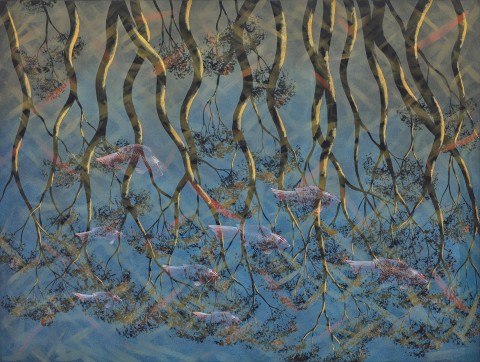MALWAN POND – DAWN, 1994
LIN ONUS
synthetic polymer paint on canvas
91.5 x 122.0 cm
bears inscription on label verso: Lin Onus / "Malwan Pond - Dawn" 1994
Gallery Gabrielle Pizzi, Melbourne (label attached to stretcher bar verso)
S&P Global, Melbourne
In 1986, while visiting Maningrida in Arnhem Land in his role as the Victorian representative for the Aboriginal Arts Board, Lin Onus first met Yolngu elder and respected painter Jack Wunuwun. It was a meeting that would deeply influence the younger artist and forever alter his life and artistic direction. Onus visited Wunuwun at Garmedi, in the artist’s homelands in Central Arnhem land, where Wunuwun adopted Onus into the Murrungun-Djinang clan – the first of what would become annual visits to the outstation, journeys that Onus would call his ‘spiritual pilgrimages.’1
Wunuwun was known for pioneering the rendering of three dimensions and perspective in bark painting by drawing on influences from European art and, in his role as mentor to the younger artist, Wunuwun was able to offer Onus a cultural haven by welcoming him into the Yolngu kinship system. This relationship revealed Aboriginal traditional knowledge to Onus, which enhanced his own Yorta Yorta experience of the world. Through Wunuwun, Onus was given an Aboriginal language he could access, together with creation stories that he was permitted to paint, acquiring a knowledge of symbols, patterns and designs from the community elders. These learnt designs became intrinsic to Onus’ art for the rest of his life where the resulting personal style juxtaposed the rarrk clan patterns with a western photorealist style of landscape, integrating Indigenous spirituality and narrative with Western representation.
Onus’ watery landscapes embrace what Wunuwun described as ‘seing below the surface’2 and function on a number of levels. Rich in reflections and ambiguities these enigmatic views clearly dispensed with the conventional idea of a European panoramic view. A landscape apparently hangs upside down from the sky. Reflected in the still water, the rising dawn sun shines golden on the serpentine tree branches and illuminates the detritus below, while a school of rarrk-covered fish swim both under the water and seemingly through the sky and the branches of the trees. As Margot Neale elaborates, these paintings are ‘deceptively picturesque, for things are not always what they seem. Laden with cross-cultural references, visual deceits, totemic relationships and a sense of displacement, they, amongst other things, challenge one’s viewing position: Are you looking up through water towards the sky, down into a waterhole from above, across the surface only or all three positions simultaneously?’3 Onus’ use of a rarrk overlay can be seen as a process of ‘indigenising the other, of claiming ownership of the land and creatures, and of subverting the primacy of Western systems of representation.4
1. Onus cited in Neale, M., Urban Dingo: The Art of Lin Onus 1948 – 1996, Queensland Art Gallery, Brisbane, 2000, p. 15
2. Neale, M. et al, Lin Onus: A Cultural Mechanic, Savill Galleries, Melbourne (exhibition catalogue), 2003, p.1.
3. Ibid.
4. Neale, op. cit., 2000, p. 16
CRISPIN GUTTERIDGE
